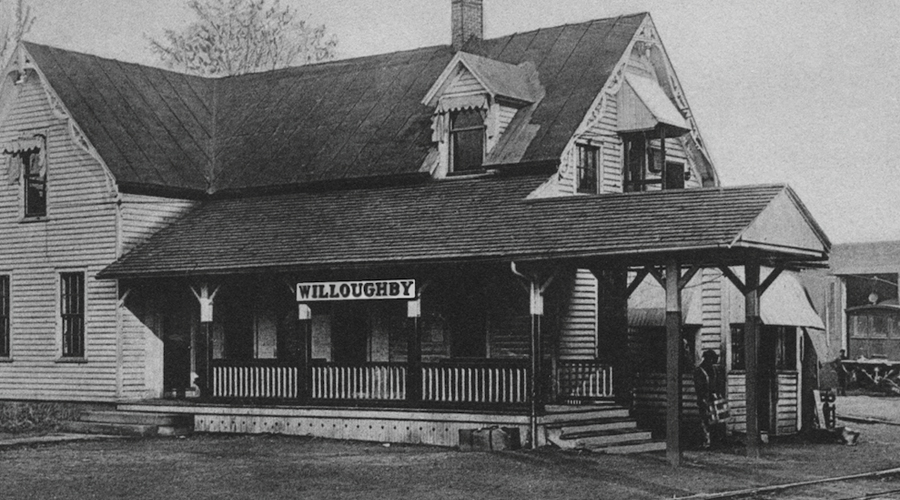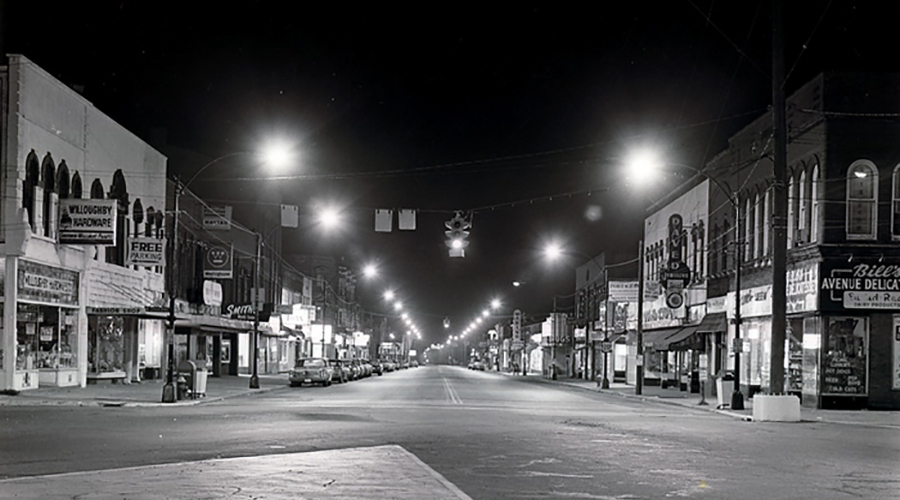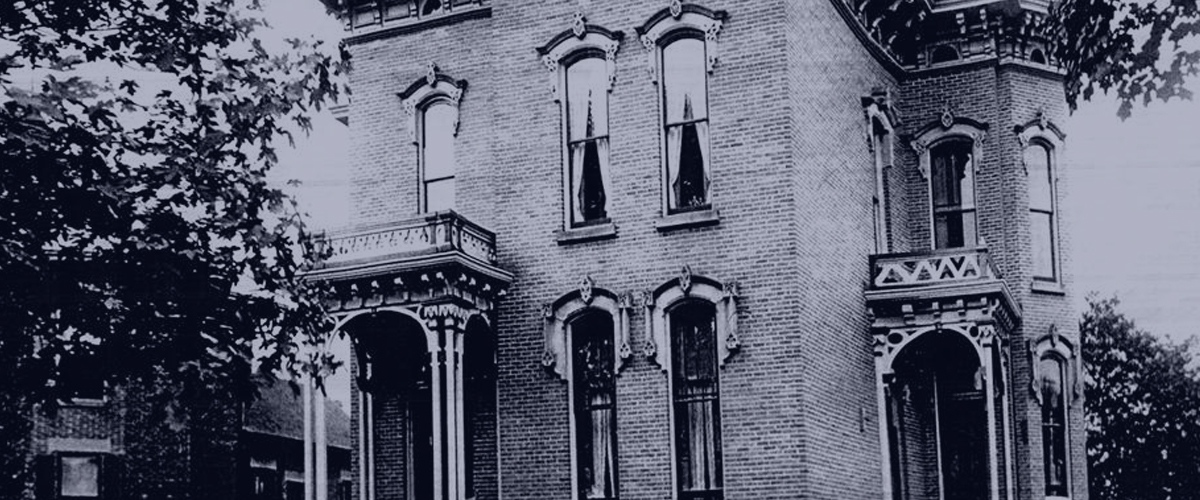Our History
Collectors of Ohio lore should love getting to know Willoughby’s history. It’s the only town in America that has belonged, at one time or other, to six counties (Washington, Jefferson, Trumbull, Geauga, Cuyahoga, and Lake). The City bore two names before the current name was adopted; Charlton and Chagrin. Colloquially, the area was sometimes referred to as Abbott’s Mill or Chagrin Mills.

Willoughby’s early history parallels that of many northern Ohio towns. The area, first inhabited by Native Americans, was explored by French trappers in the mid 1700s. In 1787, Yale graduate David Abbott made a trip west from Rome, New York. Eleven years later, Abbott acquired 200 acres including what is now Willoughby and assembled a group of pioneers to settle in the area of the Chagrin River, building a sawmill and gristmill.
In 1834 a local group of doctors established the Willoughby University of Lake Erie Medical College named after Dr. Westel Willoughby, their former professor at Fairfield Medical College in New York. That same year, Dr. John Henderson, who also served as postmaster for the Village of Chagrin, officially changed the name of the village to Willoughby.

In the last decade of the nineteenth century, Willoughby founded its municipal water and light plant, organized a fire department, and was crossed by the Cleveland-Painesville Eastern electric railway. The CPE opened Willoughby to the residents of Cleveland, who were enchanted with the scenic lakeshore area. The CPE, which ran until 1927, also brought electricity to Euclid Avenue residents.
The traditions of industriousness and integrity instilled in Willoughby in the 19th century continue today. The citizens of Willoughby have strong roots and a lot of pride in the connections to the past. Listing Willoughby’s downtown on the National Register of Historic Places ensures its architecture and history will be preserved well into the future.
How Willoughby Got Its Name
The naming of villages, cities, counties, and states in the U.S. usually evokes historical curiosity. These names may be inspired by people, geographic locations, historic events, famous cities and countries, Native American influences and even businesses, i.e., as in the many sites named “Mills”.
Since Willoughby, Ohio is the only incorporated city in the U.S. with this title, it is time to set the record straight on how Willoughby acquired this name. Hopefully, this will put to rest the many myths and legends that have distorted this fascinating history.
By now, most people should know that Willoughby is the only city in Ohio that has been part of six counties, namely Washington, Jefferson, Trumbull, Geauga, Cuyahoga, and Lake. When the Western Reserve was surveyed in 1796-97 by Moses Cleaveland for the Connecticut Land Company, some of the five-mile townships were immediately assigned names while others retained numerical designation for variable time periods. The first map of the Reserve, drawn by surveyor Seth Pease indicated that what would eventually be called Willoughby Township was originally labeled Carlton. On the next map of 1798, Carlton was changed to Charlton. The origin of this name remains unknown to date. What is known, however, is that Charlton is an ENGLISH name, literally translated as, “Charles’ Town”. In English, “ton” at the end of a city name always means town. The meandering Chagrin River which winds its way through Lake County once propelled several grist and sawmill establishments along its course to Lake Erie. Here in Willoughby, the original grist and sawmills of David Abbott have eluded precise location but did exist somewhere along this stretch between downtown and the lake outlet. Obviously, the mills proved to be the attractive nucleus of the new settlement here which, within ten years, expanded into the growing village of Chagrin(e) as described on the maps of the day.
While it is true that the first European explorers of North America, including the Great Lakes region, were French, it is also true that no Frenchmen would ever assign the English name, Charlton, to one of their trading posts. This myth of one such settlement at the mouth of the Chagrin River should be discarded. Charlton was NOT the name of a French/Indian trading post on the Chagrin. Since these early traders and missionaries referred to the Chagrin as the rivière biche, French for Elk River, that could very well have been the name of a trading post, if there ever was one there.
Five years after Ohio became a state, the name Chagrin replaced Charlton on the Pease map of 1808. There might be an explanation for this switch in nomenclature, but so far we have not discovered it. Surely the opening of the first water-powered grist and sawmills here by David Abbott in 1798 and 1799 spread the word of this pioneer, neophyte settlement on the Chagrin River, attracting other settlers from far and wide.
Unofficially, the location was sometimes known colloquially as Abbott’s Mill or Chagrin Mills. Soon everyone was referring to the place as Chagrin, (originally spelled, Chagrine) which remained the official name of the township until 1834 when it became Willoughby. But where did the river get its name? There are numerous hypotheses concerning the naming of the Chagrin River, one of the three ancient river systems in northern Ohio, the others being the Cuyahoga and the Grand. Certainly, it was not the alleged chagrin (annoyance/humiliation) of Moses Cleaveland who encountered the Chagrin before locating the Cuyahoga River! Another often repeated suggestion is that Chagrin is a corruption of a Native American word, sha-ga-rin, which supposedly means “clear water”, though this has never been confirmed by students of the Iroquoian peoples who lived in this area before the arrival of Europeans.
What seems to be the most plausible derivation for Chagrin is the Anglicization of the name of an early 18th-century French fur trader named Francois Sieur de Saquin (sometimes written Saguine) who is known to have built a trading post at the mouth of the Cuyahoga River and undoubtedly traversed the length of Lake Erie’s southern shore in his dealings with Native Americans. Did Saguin become Chagrin? The Ohio Historical Society thinks so and has erected commemorative markers offering this explanation. Of course, none of this clarifies how Chagrin became Willoughby; so let’s get on with the story.
In the early 1830s, two physicians practicing in Chagrin, Dr. John M. Henderson and Dr. George W. Card, began a quest to initiate a medical college in their hometown. The two doctors came to Chagrin in 1813 and 1819 respectively from Herkimer County, New York, where both were graduates of the Fairfield Medical College, whose president was Dr. Westel Willoughby, Jr.
Drs. Henderson and Card highly regarded their former professor and hoped to entice him to come to Ohio and head up a new medical school, which they planned to establish and name in his honor. Dr. Willoughby, an incredibly talented and multifaceted individual, kindly thanked his former students for their admirable offer but responded that he had to refuse because of his age and the poor health of his wife, Sarah.
It is crucially important to note that Dr. Westel Willoughby never saw the medical college or the town of Willoughby that was named for him. In fact, Dr. Willoughby never visited the state of Ohio. The legend that he promised to leave his estate to the city if they would rename Chagrin, Willoughby, is absolutely, positively false! Dr. Willoughby never made any deals with the village of Chagrin regarding his estate, which when he died was quite sizable. His will clearly left his oil portrait to his sister, Sarah Larned, not to anyone else including the village of Willoughby.
Dr. Willoughby lived in Newport, Herkimer County, New York where he was a man of remarkable accomplishments. Not only was he one of the founders of the Fairfield Medical College, where he was also a professor of Obstetrics and Gynecology, he eventually became its President. Additionally, he served as a physician/surgeon in the War of 1812, participated in founding the New York State Medical Society, was a judge of Herkimer County’s Common Pleas Court and in 1814, was elected to the U.S. Congress from the western district of New York. He was also a very busy medical doctor in Newport, NY, where he died in 1844 and lies buried in the First Baptist Church Cemetery.
With the support of nine other citizens of Chagrin, including two other physicians who had trained under Dr. Willoughby, Dr. Hosmer Graham and Dr. Asahel Brainard, the thrust went forward to the Statehouse at Columbus. Despite the objections and skepticism of the Cleveland medical community, which opposed this proposition, a charter was granted on March 3, 1834, by the Ohio State Legislature establishing the existence of the Willoughby University of Lake Erie, Chagrin, Cuyahoga County, Ohio.
Although Dr. Willoughby had to graciously refuse the offer of presidency of this new medical college, he affirmed his interest and support by donating $1,200, a complete medical library and an outline of the first year’s curriculum with recommendations of professors to teach the courses. In his letter to Dr. John C. Bennet, President of the Willoughby college, dated January 20, 1835, Dr. Willoughby wrote, “I fell under greater obligation than my feeble language can express, to my friends of the University located in your village, that they have honored me by naming their college after me: and again, I am under renewed obligation to my much-esteemed friends that they should deem my name worthy of designating their town.” This letter was in response to communication to Dr. Willoughby dated December 31, 1834, which notified him of the naming of the university and also the village in his honor. This would appear to provide ample evidence that the town of Chagrin was renamed Willoughby before the year was over in 1834.
However, a question remains why the United States Postal Service which began in 1813, did not officially change the town name to Willoughby until 1835. Strangely, several accounts say that the “postal” name of Chagrin was actually “Chagrin River” and was changed to Willoughby by then postmaster, Dr. John M. Henderson. This occurred while Dr. Henderson, the first doctor in Chagrin, was serving his second term as postmaster between 1830 and 1839. No doubt it was with great pride that Dr. Henderson, on April 20, 1835, hung a sign over the post office door announcing to the world that this community would henceforth officially be known as Willoughby, Ohio in honor of his esteemed professor at the Fairfield Medical College of Herkimer County, New York.
by Ronald J. Taddeo, MD
